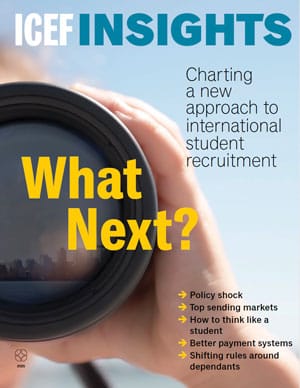Test
The following article is adapted from the 2025 edition of ICEF Insights magazine, which is freely available to download now.

This year’s sweeping policy changes in Australia, Canada, and the UK have created major challenges and confusion for thousands of schools, universities, agents, and students. But they also underline the significance of goals that many in our industry have already been pursuing, such as improving student experience and being more deliberate and targeted in marketing.
Important conversations are taking place across our sector about lessons learned from the events of this year and how to move forward, including at the inaugural ICEF Monitor Global Summit that took place in London in September 2024.
This article is based on the dialogue at that event, and even if you haven’t been directly affected by volatile policy settings, read on for insights on fresh approaches to recruiting and hosting foreign students.
Focus on student fit
Without doubt, meeting enrolment targets and diversifying sending markets remain essential goals. But there is a growing consensus that there must be an overarching mission to attract students most suited to programmes, national policy parameters, and economic trends.
This mission can be accomplished by placing a greater emphasis on recruiting for student fit.
This approach involves creating protocols and processes designed to build a carefully targeted prospect pool. Admissions offers are then sent only to students who have met criteria qualifying them as likely to acquire a study visa and complete programmes successfully.
At the end of the day, students enrolled in programmes that match their goals, academic preparedness, and financial means are much happier than students who – because they weren’t well screened – soon struggle with courses, mental health, language issues, cultural adjustment, or a higher cost of living than they can afford.
Sharpening the recruitment lens makes particular sense in destinations that have witnessed rapid growth in international student numbers over the past few years. That growth put pressure on housing, programme capacity, and student support services. It has made it more difficult for some institutions to apply quality controls and improve graduate outcomes.
How to measure success
Dr Fanta Aw, executive director and CEO of NAFSA, says that “economic value is absolutely important, that is indisputable, but we have to put students at the centre.”
She elaborates: “This means our institutions need a student success model [to guide them]. Outcome data is absolutely important. Pathways to employment are absolutely important. Fit is very, very important. And we’ve been very clear with our institutions: Do not bring international students if you do not have the structures in place to do right by those students and their families.”
Students have their own criteria
Joanna Kumpula, head of international education and integration support at Tampere University in Finland, points out that students, too, are thinking more carefully about fit: “International students are becoming much more discerning … they are now looking for niche programmes and specific career paths, and institutions must recognise these individual goals rather than relying on broad assumptions.”
Better screening leads to better outcomes
Marie Braswell, associate vice president of global strategy and market development at Canada’s Centennial College, says: “Institutions often look at student success only in terms of enrolment numbers, but we need to assess whether students are achieving academically and integrating socially.” Ms Braswell emphasises that diversification strategies remain important, but at the same time, “We also have to think about economic feasibility: Are students able to meet the cost-of-living requirements for a visa?”
Judith Lamie, pro vice chancellor for international engagement at Swansea University in the UK, explains that firm entrance requirements are required to ensure an institution is selecting students who are ready for programmes: “We should be careful about lowering entry standards for international students … this is not sustainable and sets them up for failure.”
Ms Braswell and Ms Lamie’s points emphasise that offering a “quality” experience starts well before a student is admitted. It starts as soon as the student makes contact, whether through the website, social media, an agent, or institutional staff.
Strengthening the narrative
“We know that demand for international student mobility is going to be there,” says Bobby Mehta, pro vice-chancellor for global engagement at the University of Portsmouth in the UK. “Understanding where it is, what it is, and how we can work together to [recruit effectively] in a safe, compliant, and organised way is the challenge we need to address as we go forward. [This approach] will provide national and global assurance of international education’s broader value.”
“We need a new narrative around international higher education and the global role of
universities, adds Jamie Arrowsmith, director of Universities UK International. "It’s about foregrounding the academic, social, and cultural benefits that come from internationalisation, and bringing those to the fore in the public discourse and public policy.”
The shift from quantity to quality
A shift to student-fit recruiting may change the amount of budget or staff time allocated at various points along the enrolment funnel – especially at the beginning of the transition. Preparing for recruiting will become almost as important as recruitment campaigns, because:
- Ideal student personas will need to be developed;
- Marketing and admissions staff must be crystal-clear on policies, education systems, and assessment standards in target markets;
- Agents must be thoroughly vetted and receive excellent training;
- Marketing materials, social media, and website content and structure will likely need tweaking to encourage only best-fit students to apply;
- Student journey mapping and CRM training will be essential to keeping all teams collaborating and nurturing the most promising leads.
Once the shift is underway, international recruitment will be more efficient than any kind of volume strategy. Along with a promising prospect pool, you will also have much better ratios of students approved for visas, completing programmes, landing high-skilled and well-paid jobs, and transforming into powerful alumni.
What’s more, your admissions staff can concentrate on reviewing higher quality applications rather than sifting through mountains of unsuitable ones.
Don’t forget the data
Student fit is also about better data collection and analysis so you can make evidence-based decisions to drive your recruitment plans and track what is and isn’t working. Which overseas schools and cities are yielding the ideal student profile for your programmes? Which agents? If you don’t track what is and isn’t working, the result will be sub-optimal.
“Recruitment is now much more datadriven,” says QS chief executive officer Jessica Turner. “Knowing employer needs is crucial for aligning recruitment with labour markets.”
Collecting data on post-graduation outcomes – outcomes that will improve as you commit to student-fit marketing – is also incredibly important. This is because:
- Students want to know what proportion of graduates go on to get jobs – it proves ROI;
- Employers are impressed by good graduate outcomes;
- Peak body associations are in dire need of more data to show governments the value of international education – and that means:
- Quantifying value in more ways than revenue or economic contribution;
- Demonstrating that international students are indeed essential to filling skills gaps and innovation.
NAFSA’s Dr Fanta Aw underlines the need for better data by saying: “As international education increasingly works to link student mobility to larger economic goals, the necessity of data to help address skills gaps and meet labour market demands is increasingly obvious.”
Dr Aw provides examples: “The fact that we can cite that one in four of the United States’ billion-dollar start-ups was founded by former international students is powerful. We can show that 42% of the major companies making advances in AI have been established by former international students. That’s important. We use this data to prove the value of international education.”
For additional background, please see:
- Join the ICEF Monitor Global Summit. A landmark one-day summit bringing together the industry's senior leaders, policy makers, and experts, all focused on shaping the future of the international education sector.
- "Industry experts conclude that better recruitment results begin with a focus on student outcomes"
- "Is employability still the holy grail for the new generation of international students?"
- "International education has a data problem. It’s time to do something about it"















